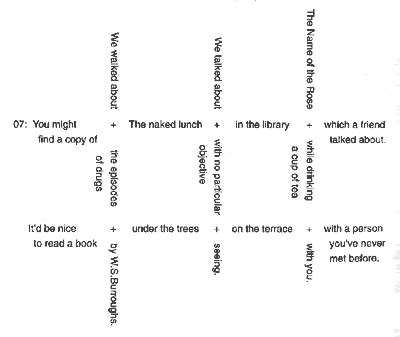

Médiathèque: A Forest Where a People and Information Interplay
01: We are always carrying along various kinds of things, such as a pocket-book, a notebook, magazines, leaflets of many kinds, an invitation card to a party, a letter from a friend, etc. While moving around, you take them out wherever you feel like doing so.02: Since the walkman came out, you don't have to listen to music in front of an audio stereo set anymore while riding a subway or crossing a street, music runs into your head without any relation to the world around you. You are now free from the restriction of when, where, and what you do. The combination of time, space and behavior has become completely free.
03: A Library has hitherto had one entrance and all of its functions are centralized inside. So it is also with museums, once you enter, there is solely a succession of exhibition spaces. You cannot enter the space and sample a few works of art while reading the book you've just borrowed, likewise you cannot slip out on the way and so something else.
04: You may feel like seeing this and that today and coming back the following day to see the rest of an exhibition. With a magnetic card check at each entrance, the exhibition can be set up in parts at different locations.
05: Here books, compact disks and video tapes are placed randomly on open shelves. As a visitor you can pick up a book and bring it anywhere you like--such as a lounge with a nice view, a gallery, a cafeteria, a performance space, or even outside under a row of trees. And when you finish reading it, you can return it to any bookshelf if you let its barcode read into a computer terminal nearby. This way books are always moving around as the users bring and return them. When you want to read a particular book, you can check it through the closest terminal, and it will tell you immediately, which shelf the book is on.
06: When you find a book you want, your attention may be caught by a book of a completely different subject next to it. This may open you to a new, unknown world which was brought incidentally by another visitor. And through the opening left by the book taken, you might witness an interesting, enjoyable workshop going on.

08: The urban landscape we experience every day is also like that. Various people with diverse purposes pass by one another at a different pace. This mediatheque is designed to incite the visitors to interplay with one another. They will compose and organize their own space, time and actions by themselves. And there, someone who was until now a complete stranger might pass by.
09: This architecture is a "Forest of Media" where people, things, time, space, landscapes, information etc. freely interplay with one another. Once you enter through a slit in the building, the unexpected will wait for you. Even without any particular purpose, one can spend time as he pleases. The visitors who stroll in the forest of media will become themselves the dispatcher who trigger the interaction with each other.
10: In an age of media technology when one can easily take out or send out any information from home. What will be the meaning of going all the way to the site?
11: The opportunities of encounters and interactions this mediatheque offers, while continually changing are becoming entangled. Taking a stroll in this sort of "information market," with all your senses wide-awake, is like window-shopping in an unknown world.
12: There will actually be various kinds of "places" : with a high ceiling, narrow, like a deep valley, where a bright light streams in, where the wind blows across, which gets wet in the rain, where the floor is sloping, where the footsteps echo, where you can hear distant sounds, cold, dark... Those variously characterized spaces will generate their own activities as a stage. They are not neutral boxes.
13: Visitors as well as artists can occupy the space as they like. And they can take any position they please. The varied spaces of the mediatheque can be modulated by numerous filters. You can combine filters of many kinds such as paper screens, lattices, glass, panels performed in complete darkness cutting off the exterior light, or a sound-installation exploiting outdoor sounds may be installed in a translucent box with numerous holes in it.
14: Someone, for example, wants to find a place to play a musical instrument. He will connect a portable terminal to an "information outlet." He will come to know at once where and what kind of place is available. In the year 2000 A.D. when this mediatheque will open, the wireless terminal will be available. An artist who is planning an exhibition will also search out the space he/she will have access to the mediatheque from his/her atelier.
15: Here you can acquire information as well as dispatch your own information. Many kinds of performances and presentations, although unrelated to each other, are occurring simultaneously. In this "Forest of Media" they will become interactive because of their accidental adjacency. The audience (who can here be creators as well) will edit their own "program" by weaving those events together.
16: The curator will be able to more actively plan a collaborative work. Furthermore, this facility may possess its. T.V. channel to dispatch its own activities day by day. The mediatheque will then become literally the citizen's communication-media.
17: All the functions here are spatially shuffled. They are not divided into levels, zones or sections. The visitors will be able to catch a glimpse of the sending-in of an exhibition, the restoration of a work, a meeting for the next project, etc... The actual spatial organization will be chaotic, but by inputting all the information about space and activities into the computer, total facility management becomes possible.
 |
 |
 |